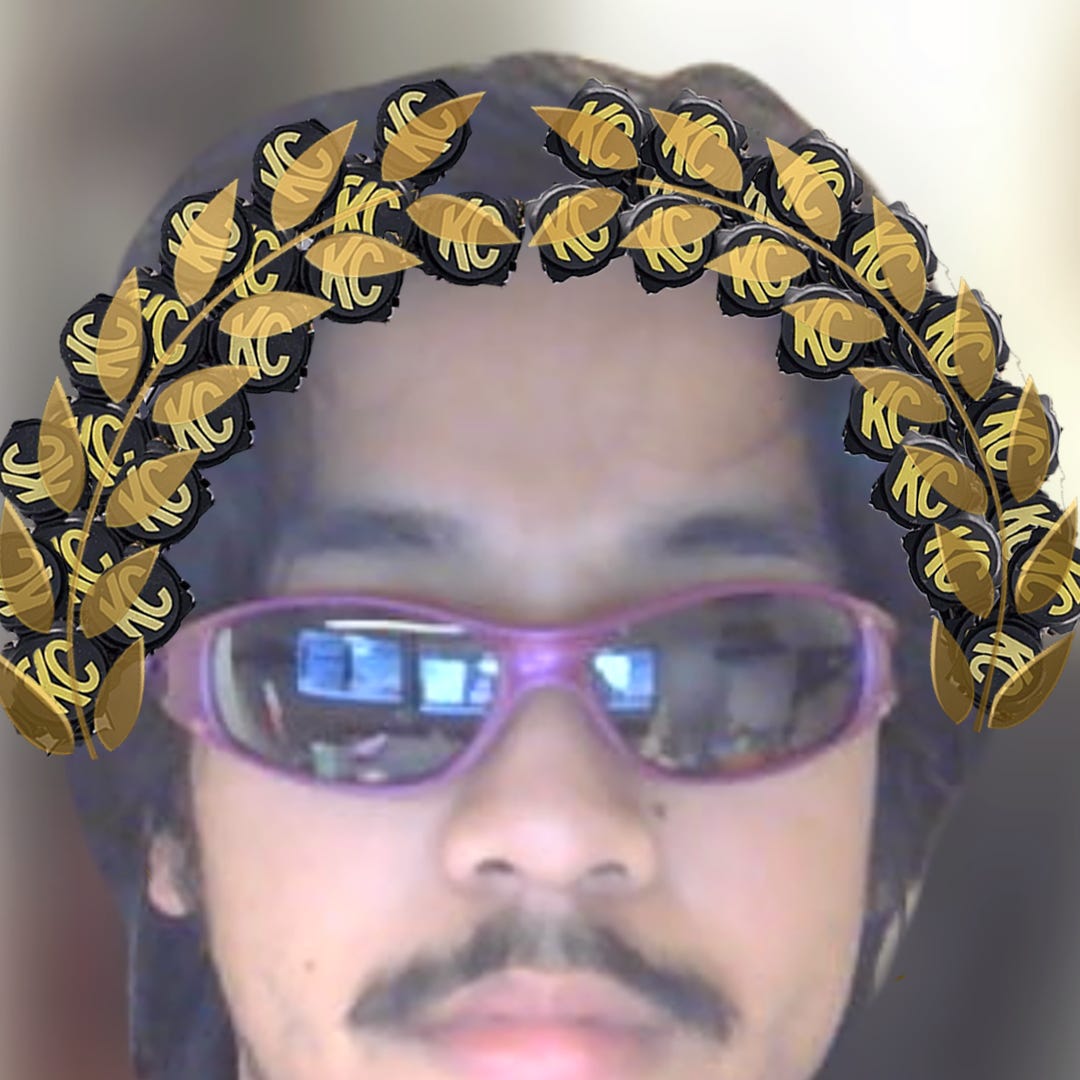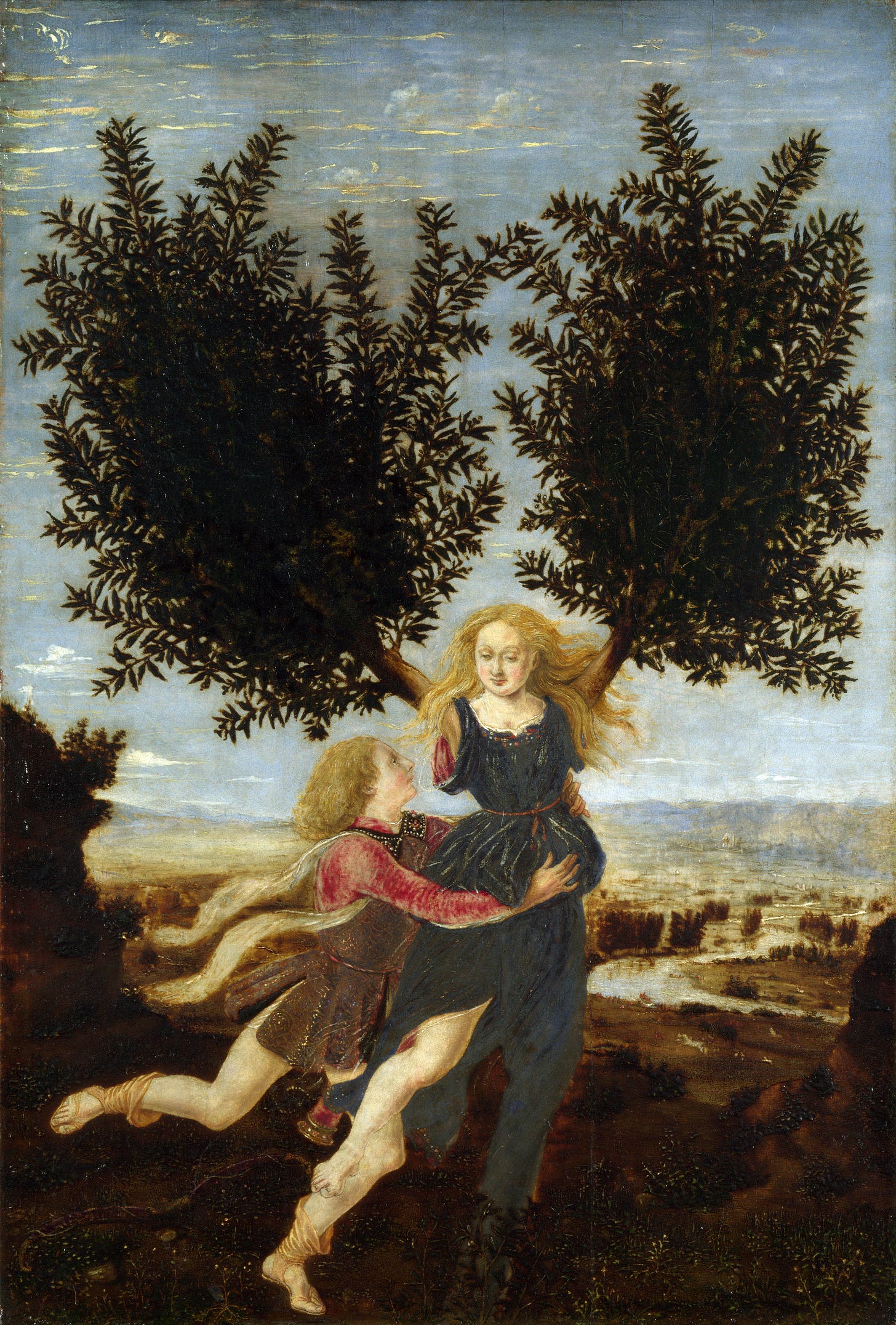I stare at myself in the mirror, purple sunglasses hugging my mask snugly.
Reminiscent of gear from the Spy Kids franchise (according to my partner), the eyeware instills within me a quirky confidence, the self-permission to serve a look while playing the fool.
I can feel that something inside me—something slight yet fundamental—has changed, as I gaze at my bespectacled self.
Such is the power of accessorizing. q(❂‿❂)p
Thus far in the life of this Substack, we’ve overviewed the Weberian origins of charisma, the fundamental relationship between memory and fame, and the main conceptual model underlying my analysis of stardom (the star pyramid!).
In this essay, we’ll continue fleshing out my theoretical framework by examining the stardom mode.
Let’s start with one of the many fucked up myths from the ancient Greeks and Romans!!! Content warning: discussion of non-consensual sexual harassment.
As Ovid sings circa 1-8 CE, the myth of Daphne and Apollo begins with the death of a giant serpent. Smug with pride and glory after slaying the beast, Apollo, the god of archery, music, and poetry (among other things), comes across Cupid (another Greco-Roman deity who makes use of the bow and arrow) and belittles Cupid’s use of the tools:
‘What are you doing with such weapons? / Those are for grown-ups! The bow is for my shoulders; / I never fail in wounding beast or mortal, / And not so long ago I slew the Python / With countless darts; his bloated body covered / Acre on endless acre, and I slew him! / The torch, my boy, is enough for you to play with, / To get the love-fires burning. Do not meddle / With honors that are mine!’1
Indignant at Apollo’s taunting, Cupid fires two arrows: “One causing love, golden and sharp and gleaming, / The other blunt, and tipped with lead, and serving / To drive all love away.”2 Into Apollo, he shoots the first, and into Daphne, a water nymph, and daughter of the river god Peneus, the second.
A chase then ensues. Apollo, now enamored with Daphne, sets off in relentless pursuit of her, while Daphne, now scornful of any romantic advances, flees. The god’s merciless hunt exhausts Daphne, and Daphne, in an act of self-preservation, calls upon her father for aid: “‘O help me, / If there is any power in the rivers, / Change and destroy the body which has given / Too much delight!’”3
Immediately, Daphne transforms into a laurel tree. Apollo, still impassioned, attempts to kiss the tree, and Daphne—even now—shrinks at his incoming touch.
But Apollo cannot be stopped. The god must have the (now-transformed) nymph, proclaiming:
'Since you can never be my bride, / My tree at least you shall be! Let the laurel / Adorn, henceforth, my hair, my lyre, my quiver: / Let Roman victors, in the long procession, / Wear laurel wreaths for triumph and ovation.’4
Thus, the (harmful) origins of the laurel as a symbol of glory and renown.
The myth of Daphne and Apollo exemplifies a common relational dynamic found between the three base components of the star pyramid (the star anchor, star launcher, and star audience). Daphne represents the anchor, and Apollo represents the launchers and audiences. Accordingly, Apollo’s ceaseless pursuit of Daphne parallels those moments when audiences and launchers become so transfixed with an anchor’s star (or by the profits generated from this star), that they pursue the anchor without mercy, much to the anchor’s exhaustion and detriment.5
But what of Cupid and his arrows? What do they represent?
As the arbiter of love who determines the nature of Daphne and Apollo’s relationship, Cupid functions as a stardom mode: a rulebook on fame that governs the dynamics of stardom. We can think of a stardom mode as a manual that star pyramids follow in order to reproduce a star. In Cupid’s case, his arrows of gold and lead create a fatalistic mode of stardom, one in which anchors are doomed to a life of over-extraction and dehumanization in service of the audiences’ and launchers’ ravenous appetites.
Stardom modes emerge from converging material and ideological factors, and they recursively inform the historical conditions from which they are born—a dialectical process that results in the continuous evolution of stardom modes. And if we track a stardom mode across spacetime, we can also see that a diversity of stardom modes exist during any given historical moment.
More fundamentally, I define stardom modes as suites of logics, norms, values, and beliefs—cosmological foundations and informatic pendulums—that answer the most basic questions informing the reproduction of fame. What underlying assumptions shape the actions of a star pyramid? What star archetypes are the most commonplace in a particular moment? What star proofs must star anchors launch at these archetypes? Who gets to be an anchor? Who gets to be a star launcher? Who gets to be a star audience? How do anchors interact with launchers, launchers with audiences, and audiences with anchors? How do star pyramids interact with collective memory? At what rate do star pyramids operate—as fast as possible, or slowly, with intention? The answers to these questions can be found in the guidebooks that are stardom modes.
To better understand this concept, let’s compare and contrast two stardom modes.
Let’s start with Roman stardom, the prevailing mode of Ovid’s time.6 As cultural historian Leo Braudy describes in his classic text, The Frenzy of Renown, Roman stardom centers around public glory in service of the Roman state.7 Contribute greatly to the strength and authority of Rome, and be enshrined as a hero. The role of star anchor is primarily reserved for men born into noble classes, and the main target archetypes of these aristocratic Roman men include the warlord, politician, and orator. To aim at these archetypes, aspiring anchors must launch proofs related to victory and conquest: they must defeat a foe and win something in public—be it a military battle, a political office, or a rhetorical contest—all for the glory of the Roman state.
This tenet of Roman stardom is best exemplified in the phrase cursus honorum, a term that ancient Romans use to describe the ladder of public offices that aristocratic men can climb. Braudy translates cursus honorum as the “racetrack of honors.”8 Such a translation highlights the centrality of competition and victory for Roman stardom. To gain public renown in Rome, one must contribute to national glory by competing in public games related to civic and military duty, and one must win.
In contrast to the Roman stardom mode, let’s consider how fame manifests in the context of the Anishinaabeg peoples, the Indigenous communities of the Great Lakes region on Turtle Island (so-called ‘North America’). As Anishinaabeg scholar Renée E. Mazinegiizhigo-kwe Bédard writes, Anishinaabeg stardom centers around the mino-waawiindaganeziwin:
Mino-waawiindaganeziwin describes the character of a person of worth, esteem, respect, fame, or renown. In Anishinaabeg cultural contexts, it is not a word used by people to describe themselves. Instead, such a description is bestowed on an individual only by someone else in the community. An individual who is mino-waawiindaganeziwin is recognized for leadership, talents, expertise, or gifts that contribute to the vitality of Anishinaabeg culture, community, and nationhood; conversely, the person might be recognized for the lack of those qualities. The word has a double meaning for either the best or the worst qualities of character that a person can exhibit within the community.9
If I may graciously place mino-waawindaganeziwin within the framework of stellar mechanics, then we can understand that the mino-waawindaganeziwin exists as the primary star archetype of Anishinaabeg stardom, in contrast to the Roman archetypes of warlord, politician, and orator. For the Anishinaabeg community to name an anchor as mino-waawiindaganeziwin, an Anishinaabeg person must launch proofs that embody and exemplify the cultural codes of the Anishinaabeg worldview and lifeway. Bédard provides more detail about this:
Within Anishinaabeg society, an upstanding human being is required to embody Anishinaabe mino-bimaadiziwin (living the good life or good way as a human being) and respect the Anishinaabe-inaakonigewinan (natural laws). Anishinaabeg Elder Sherry Niizhoosake Copenace (Onigaming First Nation) offers that ‘Anishinaabe are taught to be dedicating themselves to be aware [of ] and caring to everything within and around you, at every moment and in daily life.’ Supporting this, Anishinaabeg-Métis scholar and lawyer Mikinaakikwe Aimée Craft adds that the ‘Anishinaabe way of life is centered on relationships, and responsibilities are associated to each of those relationships. These relationships give rise to rights, obligations and responsibilities. Rights, obligations and responsibilities are exercised both individually and collectively by the Anishinaabe.’10
Here, we can see that the tenets of collectivism, relationality, and responsibility stand as the guiding values of the Anishinaabeg stardom mode. In place of Roman stardom’s focus on conquest and competition—on patriarchal and imperialist domination—we find an emphasis on respect, duty, and care for the more-than-human web of life.
There is, of course, much more to write about the Roman and Anishinaabeg stardom modes (as well as other stardom modes, like Christian, medieval, and Information stardom!), but this essay has taken long enough for me to send out already, so I’ll end it here. ;p
The main conclusion I’ll draw is that stardom modes are one of the most important points of intervention to consider when it comes to critiquing and transforming fame. If we zoom out and investigate this overarching stardom component, we can better understand that when we bemoan the ills of the ‘cult of celebrity,’ what we are really critiquing are specific stardom modes that reproduce obsessive and harmful fame dynamics. But not all modes are like this, as illustrated with Anishinaabeg stardom—not all modes follow the golden and lead arrows of Cupid.
Dreaming up re-enchanted stardom modes that better align with more care-full, convivial, and liberatory futures stands as one of the foundational goals of this project.
Thank you for your patience as I send this one out, and for your time and attention!!
Wishing everyone well until the next one. <3
KC
Ovid. (2018). Metamorphoses (R. Humphries, Trans.), p. 17. Indiana University Press. (Original work published 1-8).
ibid
ibid, p. 19
ibid, p. 20
We can think of, as an example, the tabloid frenzy surrounding Britney Spears and her star circa the mid-2000s. Here, Spears is anchoring one of the brightest global stars to shine as the new millennium turns, and the accompanying increase in media heat and pressure brings more and more challenging moments to Britney that are broadcasted to millions around the world. Years of unrelenting paparazzi chases and tabloid headlines crest in 2007, as Spears performs her zeitgeist-defining head shave.
I must note that this discussion of Roman stardom makes sweeping generalizations about centuries of Roman history that includes the fall of the Roman Republic and the emergence of the Roman Empire. There are definitely many nuances to Roman stardom that can be identified if we dive into the specific historical developments of Ancient Rome, but I do think that Braudy supports the idea that the fundamental tenets of Roman stardom persist throughout this wide-ranging time period.
Braudy, L. (1997). The Frenzy of Renown. Vintage Books.
ibid, p. 61
Bédard, R. E. M. (2021). Mino-Waawiindaganeziwin: What Does Indigenous Celebrity Mean within Anishinaabeg Contexts? In J. Adese & R. A. Innes (Eds.), Indigenous Celebrity: Entanglements with Fame (p. 24). University of Manitoba Press.
ibid, p. 39




